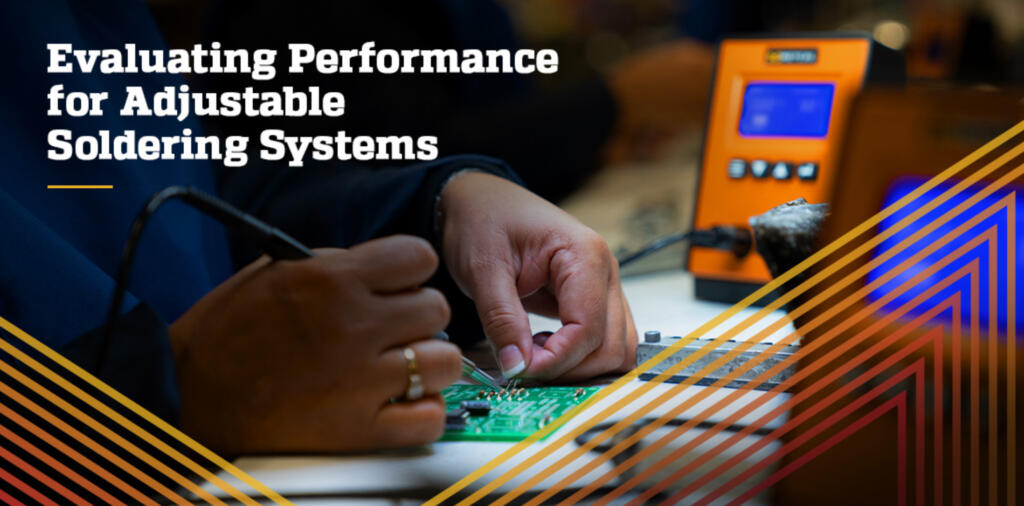Evaluating Performance for Adjustable Soldering Systems
When looking at performance for hand soldering in electronics manufacturing, Operations Engineers need to be very focused on three key metrics: time to temperature, dwell time, and thermal recovery. These three metrics together will identify the best soldering product for the production line and will help maximize throughput and lower scrap in the process.
Time to temperature
Time to temperature is measured by how fast the soldering iron heats up on initial start-up, or when it is “woken up” and removed from the cradle. Time to temperature is crucial because it can be considered as lost minutes of manufacturing every day. Many soldering products in the market can take tens of seconds for initial heating of the iron, leading to lower productivity. Over a shift (or multiple shifts) this wasted time spent waiting to solder can become quite significant.
Dwell time
Dwell time, sometimes referred to as temperature stability, is based on how long it takes to solder a specific joint. As the hot tip comes in contact with the solder joint, the dwell time is directly related to how well the soldering iron is able to keep temperature stable while losing heat due to thermal transfer during the soldering process. Lower performing units often will dip significantly during this process and can have trouble getting back to temperature, elongating the process. This is especially true with higher thermal demand applications.
Recovery time
Recovery time is the time it takes for a soldering iron to return to temperature after completing a solder joint and is ready to begin the next. Like time to temperature, this time can vary significantly from model to model and can have the effect of losing tens of minutes to hours a day of manufacturing.
When evaluating performance, most engineers first look to the power consumption of the unit. Though it is true that if all else is equal, a 150W product will outperform a 75W unit, it is rarely the case that all else is equal. Examples of variables that can affect this include placement of the heater versus the soldering tip, the type of heating technology used, and even differences in the engineering of same heater technologies. For this reason, looking at the wattage of the unit is only one factor to consider.
Where the heater is located versus the soldering tip is very important to the performance of the system. The closer the heater is to the tip, the faster it heats up. For this reason, one-piece cartridges, which allow for the heater to be located right at the tip will generally offer faster time to temperature, dwell time, and recovery time vs. two-piece designs that have the heater in the shaft and a replaceable tip. Two-piece designs tend to be significantly less costly though as the tip wears out much faster than the heater cartridge, meaning that only the tip needs to be replaced most of the time without replacing the entire heating mechanism.
Heating technology in soldering comes in two forms, Resistive and Inductive. Resistive heating is an indirect form of heating the soldering iron and therefore, takes longer due to thermal loss in the system. To make up for this, higher power is needed. Although most soldering systems on the market today utilize resistive heating technology, there are significant differences from manufacturer to manufacturer which can affect the performance of the system.
Inductive heating on the other hand, is a more direct and efficient method of heating the soldering iron, and therefore much faster at heating a soldering tip than resistive technology.
The New GT Series Offers Adjustable Temperature with Inductive Heating
The new GT Series of Soldering Stations are the first and only soldering stations available that offer adjustable temperature with inductive heating. In fact, these new products outperform (by as much as 35%) 250W systems on the market today with just 120W of power. This enhanced performance provides operators on the production line the advantage of using two-piece tips for lower cost while still getting improved performance over competitive resistive systems. If ultimate performance is preferred, the GT systems are also compatible with one-piece cartridges to meet high thermal demand needs.
Evaluating the performance of a soldering system is key to making sure you have the right product for your manufacturing line. Time to temperature, dwell time and recovery time will relate directly to the throughput of your operators and should be looked at while demoing a unit and running it through your evaluation process. Understanding the construction of the tips and the technology used in the system will also help in your evaluation.
Metcal’s new GT90 and GT120 adjustable soldering systems, powered by inductive heating offer best-in-class performance.
For more information on these systems, please look to our website for more documents and information or contact your distributor or salesperson.

